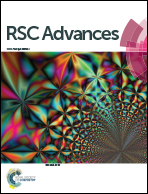Scalable synthesis of Li1.2Mn0.54Ni0.13Co0.13O2/LiNi0.5Mn1.5O4 sphere composites as stable and high capacity cathodes for Li-ion batteries†
Abstract
Li-rich materials have become a very promising kind of cathode materials due to their high specific capacities and working potentials. Herein, we successfully synthesized a high voltage cathode of Li1.2Mn0.54Ni0.13Co0.13O2 spheres coated with thin LiNi0.5Mn1.5O4 layers via a simple co-precipitation method. The finally obtained composite cathode was examined by scanning electron microscopy (SEM) and transmission electron microscopy (TEM), clearly confirming that the inner core was completely uniformly coated by the outer shell. X-ray powder diffraction (XRD) and energy dispersive spectrometry (EDS) results show that the products have no other component. The coated composite cathode exhibited a superior rate capacity and stable cycle performance in a voltage range of 2.0–4.8 V. The Li1.2Mn0.54Ni0.13Co0.13O2/LiNi0.5Mn1.5O4 microsphere cathode delivers high capacities of 249.5 and 96 mA h g−1 at rates of 0.2C and 5C, respectively.


 Please wait while we load your content...
Please wait while we load your content...